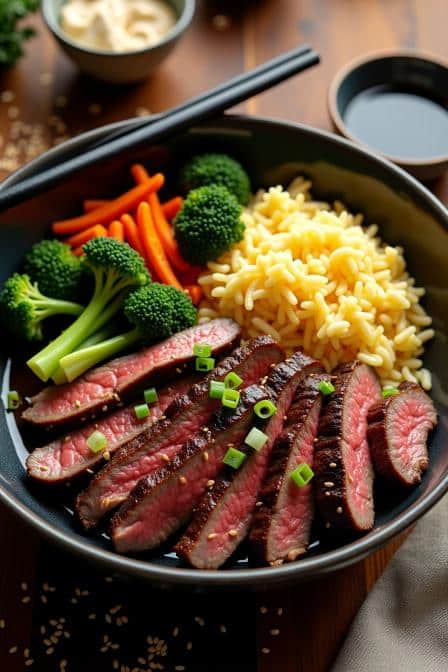There’s this thing that happens when steak hits a smoking-hot grill. It talks. Not words exactly, but a whispery hiss, a little crackle, maybe a shout when the fat pops. I used to wait in line at my local hibachi spot, hypnotized by the rhythmic clang of spatulas and that unmistakable smell—sweet soy, toasted garlic, and the caramel bite of seared beef. Then one day I thought, “Why not bottle that magic at home?” That’s how these hibachi steak bowls became a weekly ritual in my kitchen.
This isn’t just any steak bowl. We’re talking sizzling medium-rare slices of marinated ribeye, a fried rice that flirts with umami, seared veggies that still got their crunch, and that molten, glorious garlic butter that slides across everything like a silk robe on tile. You don’t need a teppanyaki table or a juggling chef (though, bonus points if you’ve got one). Just a cast-iron pan, some high heat, and a wild respect for flavor.
Let’s dive into the anatomy of what makes this bowl so dang special—and how to make it sing in your own kitchen.
What Makes Hibachi Steak Bowls Special?
Hibachi-style cooking is more than a dinner show. It’s rooted in Japanese teppanyaki, where chefs cook on a flat iron griddle, often right at your table. But don’t confuse it with traditional Japanese home cooking—this is more of a Westernized hybrid that’s exploded in popularity across American steakhouses.
What makes the hibachi steak bowl different?
- High-heat sear: We’re building flavor through browning. That means sizzling steaks in a ripping-hot pan until a crust forms, locking in juices while developing complex Maillard compounds.
- Garlic butter umami: It ain’t hibachi without that hit of garlic butter spooned over rice, veggies, and meat. It binds everything together and gives that luscious, slightly indulgent edge.
- Sweet-savory marinades: Soy, mirin, sesame oil, and a whisper of sugar do wonders to the beef.
- Balanced bowl composition: You’ve got protein, starch, veg—all in harmony. It’s a full meal but doesn’t feel heavy.
Now let’s talk ingredients. Get your notepad (or iPhone Notes app, I won’t judge).
Ingredients & Substitutions
Here’s the full lineup for a killer hibachi steak bowl. Swaps are included for flexibility.
Main Ingredients Table
| Ingredient | Purpose | Substitution / Notes |
|---|---|---|
| Ribeye steak (12 oz) | Main protein, tender + marbled | NY strip, sirloin, or tofu (for vegan) |
| Jasmine rice (1.5 cups) | Base starch, fluffy + fragrant | Sushi rice, basmati, or cauliflower rice (low-carb option) |
| Soy sauce (3 tbsp) | Marinade + seasoning | Tamari (gluten-free) or coconut aminos |
| Mirin (1 tbsp) | Sweet acidity for marinade | Rice vinegar + ½ tsp sugar |
| Garlic (6 cloves) | Key flavor in butter & stir-fry | Garlic paste or powder (not ideal but usable) |
| Butter (4 tbsp) | For garlic butter | Ghee or plant-based butter |
| Carrots (2) | Veggie component | Zucchini, bell pepper, or mushrooms |
| Broccoli florets (2 cups) | More veggies | Snap peas or green beans |
| Eggs (2) | Fried rice richness | Omit for egg-free; sub with tofu crumbles |
| Sesame oil (1 tbsp) | Finishing oil for nuttiness | Toasted peanut oil or neutral oil with sesame seeds |
| Scallions (for garnish) | Aromatic topper | Chives or finely diced shallots |
Pro tip: Always buy ribeye with a decent marbling. That fat renders beautifully during the sear. If you can swing Prime grade—go for it. It makes a world of difference.
Step-by-Step Instructions
We’ll cook this in stages: rice, steak, veggies, garlic butter, and assembly. Multitasking helps, but don’t rush it. Let’s break it down.
1. Cook the Rice
Start here. Rice takes time and it holds heat like a cozy blanket.
- Rinse 1.5 cups jasmine rice until the water runs clear.
- Cook in 2 cups water (yes, slightly less for firmer rice), then fluff and cool on a sheet pan.
Expert tip: Cold rice fries better. Make it the night before if ya can. Fresh rice = mushy fried rice. We want individual grains, not rice pudding.
2. Marinate the Steak
Slice your ribeye into thin strips against the grain. Always against. Otherwise, you’ll be chewing forever.
Mix marinade:
- 3 tbsp soy sauce
- 1 tbsp mirin
- ½ tsp sugar
- 1 clove grated garlic
- 1 tsp sesame oil
Toss steak in marinade. Let sit for 20 minutes. Not too long—you want flavor, not mushy meat.
3. Make the Garlic Butter
In a small saucepan:
- Melt 4 tbsp butter over low heat.
- Add 3 minced garlic cloves.
- Let it gently sizzle until golden, not brown.
Add a pinch of salt. Done. This butter will transform everything it touches.
4. Fry the Rice
In a large skillet or wok:
- Heat 1 tbsp neutral oil over medium-high.
- Add 2 whisked eggs, scramble, then push to the side.
- Add your cold rice. Break it up with a spatula.
- Toss in 2 tbsp soy sauce, a drizzle of sesame oil, and the scallion whites.
Mistake to avoid: Don’t overcrowd the pan. Rice needs contact with hot surface to crisp, not steam. Work in batches if necessary.
5. Sear the Veggies
In another pan (or same one wiped clean), heat 1 tbsp oil.
- Add sliced carrots and broccoli florets.
- Stir-fry until just tender, about 4–5 minutes.
- Season with a dash of soy and garlic.
You want them still bright, still snappy. Overcooked broccoli = sadness.
6. Sear the Steak
Get that cast-iron skillet HOT. Like, smoke-alarm hot.
- Add 1 tbsp oil.
- Lay steak slices in a single layer.
- Don’t move for 1 minute. Then flip.
Cook until golden-brown edges and just medium-rare inside. It happens fast. 90 seconds per side, max.
Drizzle a spoonful of garlic butter over the steak in the last 30 seconds. It’ll bubble and smell absolutely outrageous.
7. Assemble the Bowl
Layer as follows:
- Base of fried rice
- Pile of seared veggies
- Slices of steak fanned out
- Garlic butter drizzled over everything
- Sprinkle scallions on top
Want heat? Hit it with chili crisp or sriracha. Feeling extra? Add a soft-boiled egg. You earned it.
Cooking Techniques & Science
Why Sear First?
The Maillard reaction is the golden-child here. When meat hits high heat, proteins and sugars reorganize into hundreds of new flavor compounds. Searing before anything else ensures those flavors anchor the dish.
Low heat won’t do. It’s gotta be ripping hot to crust fast before juices escape.
Why Cold Rice?
Fresh rice = moisture overload. In fried rice, moisture is the enemy. Cold rice has dried a bit, so it crisps instead of steams. It also separates easily—no clumpy mess.
Tools That Matter
- Cast-iron skillet: Unbeatable heat retention. Searing is not a job for a nonstick pan.
- Wok: Best for high-heat tossing of veggies and rice.
- Rice paddle: Helps keep rice fluffy and separate.
Storage & Reheating
Store leftovers in airtight containers for up to 3 days.
Reheat rice in a skillet with a splash of water. Cover for steam, then uncover to crisp. Microwave? Works, but the texture suffers.
Steak: Reheat gently in a pan with butter or slice cold over a salad.
Variations
- Vegan: Sub steak with marinated tofu or tempeh. Use plant-based butter.
- Spicy: Add chili garlic paste to marinade or top with jalapeños.
- Low-carb: Use cauliflower rice and bulk up on veggies.
- Gluten-free: Use tamari or coconut aminos.
Serving & Pairing Suggestions
These bowls plate beautifully with contrast—dark steak, green veggies, golden rice. Use wide bowls, not deep ones. Let the components shine.
Garnish with sesame seeds, pickled ginger, or nori strips if you wanna flex.
Drink Pairings:
- Cold Japanese lager
- Iced green tea
- Sake spritzer with lime
Want a starter? Try miso soup or a simple cucumber salad with rice vinegar.
Best Time to Serve This Dish
Honestly? Anytime you want something hearty and flashy. But it hits especially good:
- Post-gym dinner (hello protein)
- Date nights (it’s sexy food, don’t argue)
- Friends over for DIY hibachi night
- Late lunch when leftovers from yesterday just won’t cut it
It’s not fussy, but it feels special. That’s the sweet spot.
Conclusion: Why This Bowl’s a Keeper
This hibachi steak bowl is more than a riff on restaurant fare. It’s a study in contrast and balance—heat and fat, crunch and chew, savory with a touch of sweet.
Mastering this at home gives you restaurant-level confidence. It’s customizable, craveable, and packed with skills that’ll sharpen your whole cooking game.
Final pro tips:
- Don’t skip the garlic butter. Just don’t.
- Sear in batches to avoid soggy beef.
- Use day-old rice. Or regret everything.
Go forth and sizzle.
FAQs
Q1: Can I make this dish ahead of time?
Yes! Cook the components separately and store them. Reheat rice and steak just before serving. Add fresh scallions or toppings at the end.
Q2: What cut of beef works best besides ribeye?
Sirloin, strip steak, or even flank (if marinated longer) are solid options. Just slice against the grain for tenderness.
Q3: Is a wok necessary for this recipe?
Not at all. A large nonstick or stainless pan works fine—just make sure it’s hot enough to sear properly.
Q4: How can I make it healthier?
Use cauliflower rice, leaner beef, or more veggies. Reduce butter or use olive oil in place.
Q5: Why does restaurant hibachi taste different?
Partly the equipment (super-hot flat tops), partly MSG, and partly the ambiance. But with the right ingredients and timing—you’ll get real close at home.
Let that garlic butter melt. Let the rice crisp. Let the steak speak.

